General accounting
III. 10. The recording of debtors and creditors: emergence of double-entry accounting
Video
In the previous lesson, we saw that an IOU which arrives in the firm as a payment for something cannot be recorded in the tally of cash. Yet it is value which comes into the assets of the firm, later to be transformed into cash.
Instead of covering the page recording cash with plenty of margin notes when we receive IOU's, we record them on another page called "debtors".
What does this page look like?
Well, it is very simple: we list the clients and their IOU's, and put the amounts in one column called naturally enough... debit.
The layout of this page, in its first version (not its final form) is this
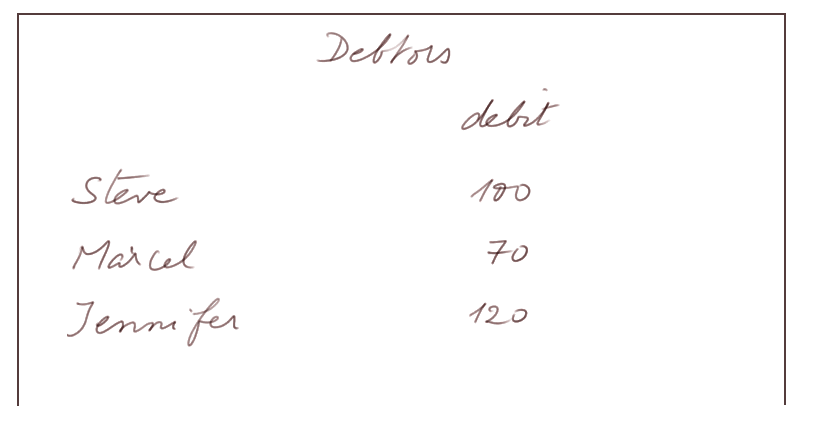
Similarly, when we pay a supplier with an IOU to be transformed later into cash, we record it on a page entitled "creditors".
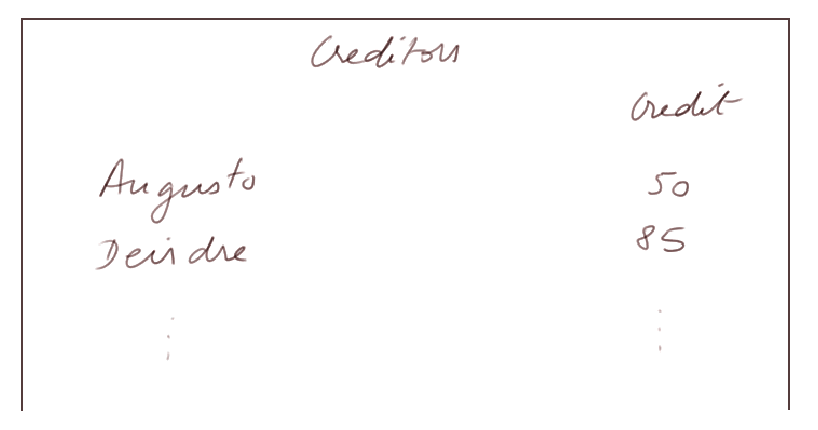
Then, what do we do when Steve pays?
We could cancel the 100 (erase the entry for Steve) in the "debtors" page, and enter +100 into the cash tally (like the money from Gran'ma).
But that is not what we do. (Indeed, accounting is an information gathering process, so we don't want to erase useful information even if it is past and seems no longer relevant.)
We make another entry in the "debtors" page, in another column
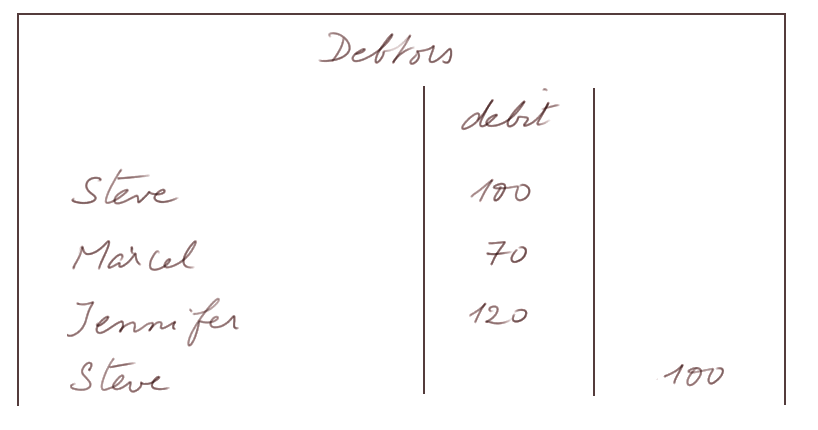
and we add 100 in the tally of cash.
Why not write -100 in the debit column?
Double-entry accounting was invented in the XIIth and XIVth centuries during the fantastic development which Western Europe went through. It was the times of demographic growth (we began to need family names), creation of universities, building of "gothic" cathedrals, emergence of big trade fairs, of banking, of the crusades and the Knights Templar (whom some authors credit with the first invention of the bill of exchange).
The Arabic numbers were also introduced in Western Europe in that period: first by Gerbert of Aurillac, later pope Sylvester II, who around the year 1000 invented a new type of abacus to replace computation with Roman numerals, and then by monks in the XIth and XIIth centuries who translated Al Khwarizmi, and finally by merchants and by Fibonacci, the son of a merchant, in his book "Liber abaci" in 1202. The Arabic system of notation and calculation was very new and quite abstract and spread slowly in Europe. Roman numerals remained in use in some parts of the continent until the XVIIth century!
Double-entry accounting, the invention of which was made possible by the Arabic system, was also quite new and even more abstract. To this day, some people have remediless difficulties with the technique. But it was necessary to the trade of merchants. Fibonacci was the son of a Pisan merchant who spent some time in Bejaya, on the eastern Algerian coastline. That's where Fibonacci himself learned about the Arabic numbers.
The algebraic signs + and - were not yet invented. They first appeared around the year 1500.
When we pay, say, Deirdre, we do the symmetrical thing: we make another entry in another column in the "creditors" page.
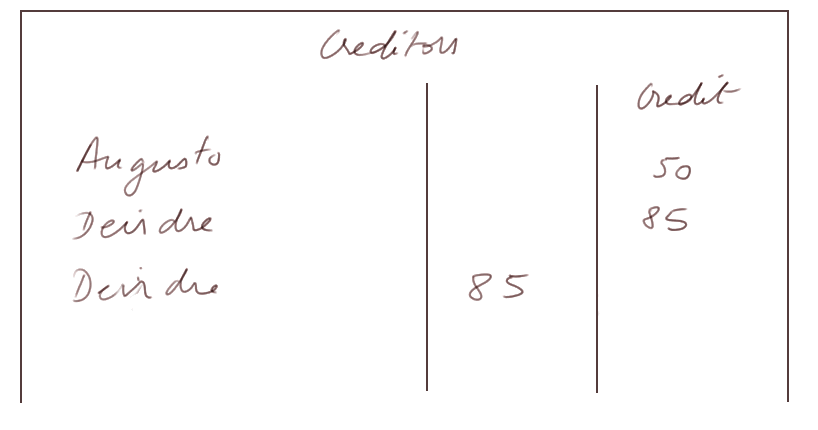
Movements of value:
- Receiving an IOU is value coming into our firm
- Having an IOU paid (transformed by a client into cash we receive) is value "leaving" the "debtors" page and entering the cash tally
- Paying a supplier with an IOU is value leaving our firm, recorded in the "creditors" page
- Cancelling an IOU, that came due, and paying cash is value leaving the cash tally and somehow "entering" the "creditors" page, where it "annihilates" a credit from a supplier
Italian merchants observed that, on the "debtors" page, the column next to the "debit" column worked like the "credit" column of the "creditors" page.
Indeed, the last entry of 100, in the column next to "debit" (see picture below), is value leaving the firm since it annihilates the first IOU received from Steve. Of course at the same time we will record cash entering the firm. This will be done in the cash tally.
So the Italian merchants called the column next the "debit" column, the "credit" column.
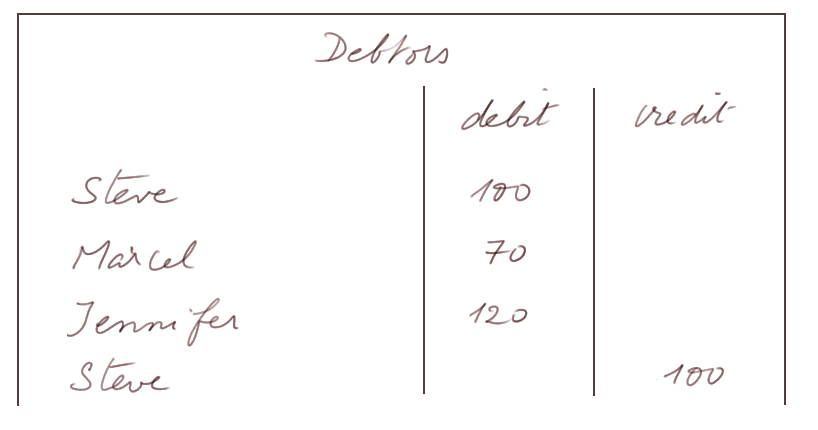
The same observation applies to the "creditors" page: when we pay a creditor, it cancels our own IOU which we had given to the creditor. Therefore it is like value coming back into the firm, i.e. entering the firm. So it is natural to record it in a column called "debit", as we did on the "debtors" page. And again, at the same time we will record that cash leaves the firm: this is done in the cash tally (= cash page = cash account).
Of course, in the "debors" page, we could call the "debit" column the "+" column, and the "credit" column the "-" column, since we make an entry in the debit column when we add some value to the debtors account, and we make an entry in the credit column when we remove value. But, once again, when double-entry accounting was invented, "algebra" (derived from the title of the book "Kitab al-Jabr" by Al Khwarizmi, written around 820 ad) was a quite new and abstract discipline in Europe, and these signs + and - were not yet invented.
The procedure of recording in a debit column value coming in, and in a credit column value leaving, can perfectly be used for the cash tally as well.
It will be called the "cash account".
And the two columns will be generalised to all sorts of "pages" (which will be called accounts) recording values of the same nature (cash, debtor paper, fixed assets, etc.).
We are finally in a position to look at the recording of a transaction.
Let's see how we record the transaction: buy a van, paying with cash
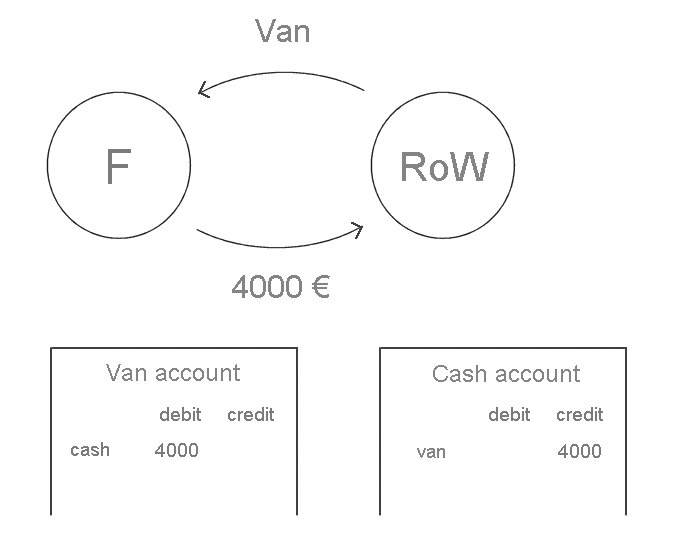
When the firm buys cash a van, it will record value coming in the firm (a van), in an account called "van account" (or more formally "transportation equipement account"), and value leaving the firm (here, cash) in the "cash account".
Why double-entry accounting is often perceived as so difficult, and debits and credits so puzzling?
Answer: because many accounting manuals do not explain the origin of the recordings in the debit and credit columns, limiting themselves to edicting in the first pages a collection of rules such as "value coming in is a debit somewhere, and value leaving is a credit". We may even occasionally run into the "explanation": "debit means left, and credit means right".
We think that a detailed presentation of the origin of the recordings in the debit and credit columns makes double-entry accounting easier to learn.



